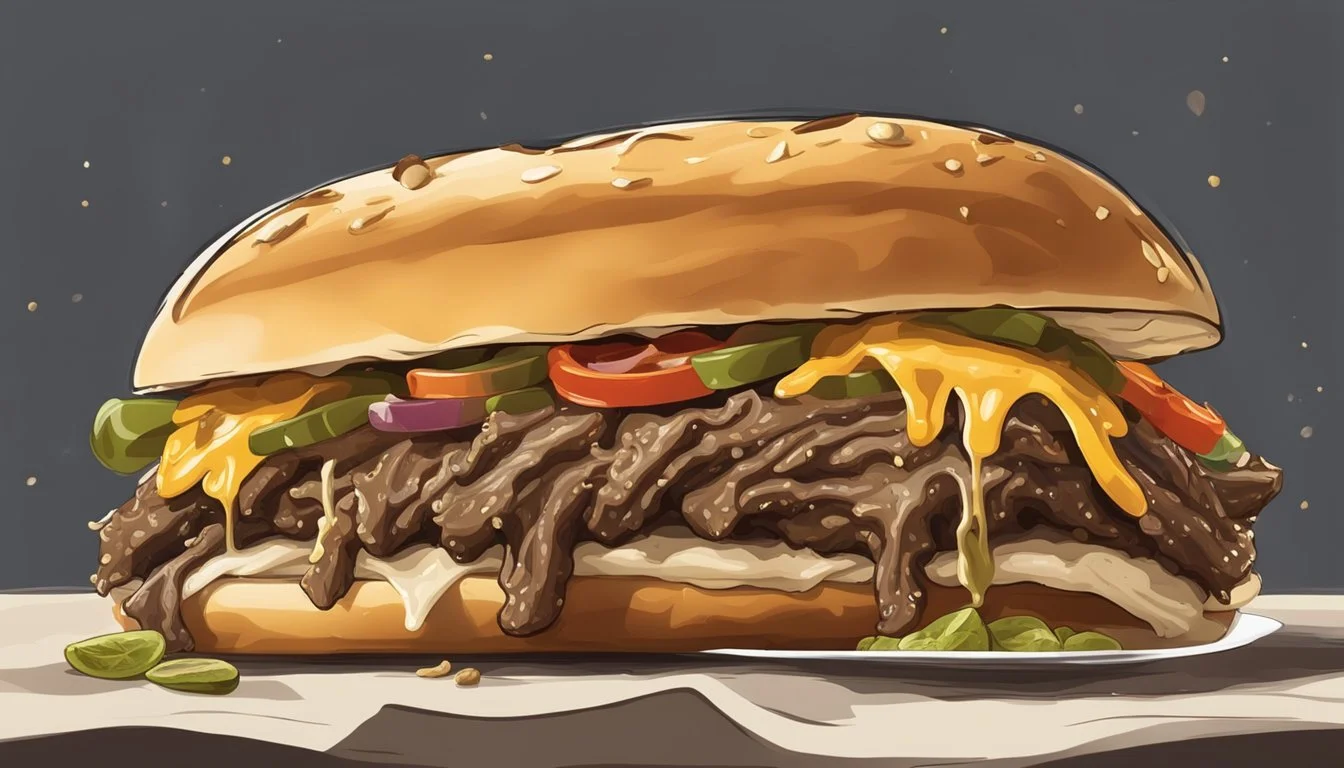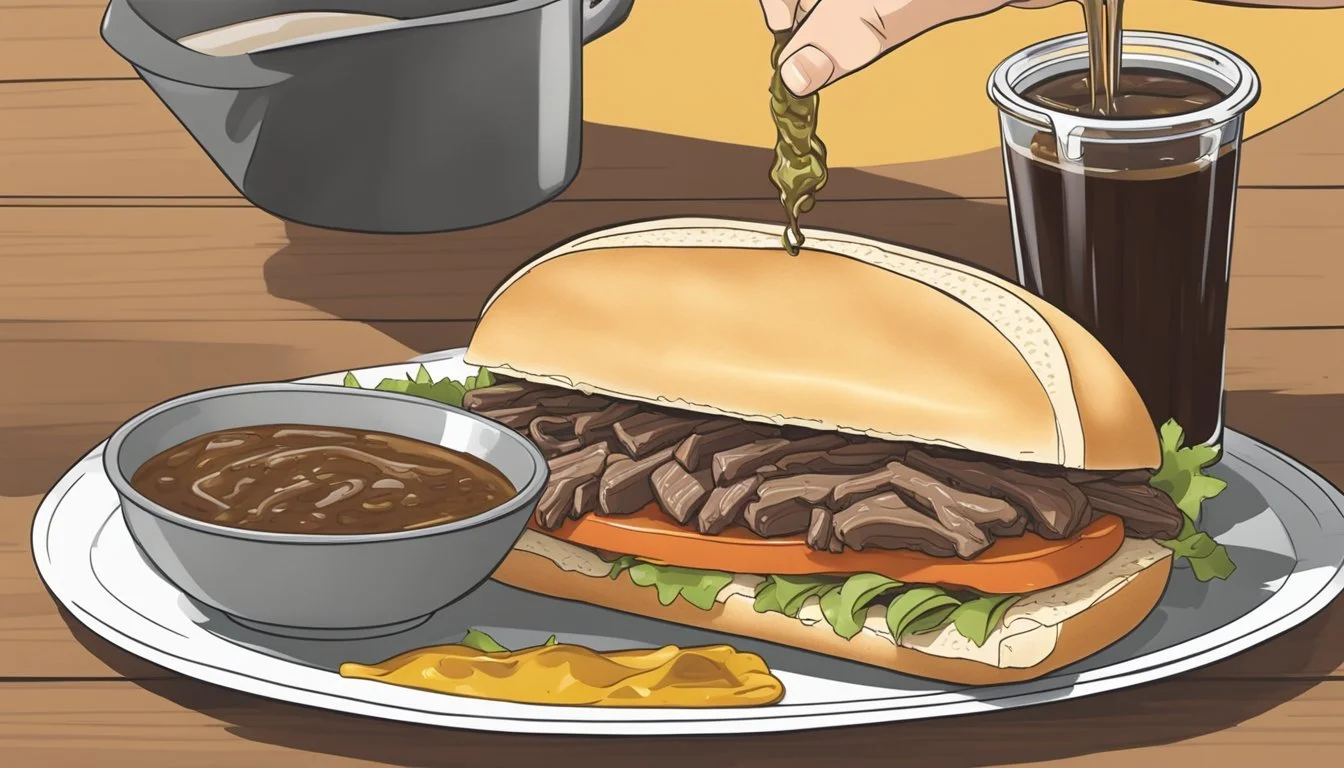How Do You Eat an Italian Beef Sandwich?
Tips for Enjoying This Classic
An Italian beef (What wine goes well with beef?) sandwich is a culinary classic hailing from the streets of Chicago, where it emerged as a beloved staple. The sandwich comprises thinly sliced roast beef, which has been simmered to perfection in a seasoned broth, adding layers of flavor. It is typically served on a dense, long Italian-style roll that has the capability to hold up to the juiciness of the meat without falling apart.
Eating an Italian beef sandwich is an experience in itself. It requires a technique known as 'the Italian stance' to avoid a mess, owing to the generous amount of gravy or au jus that the beef is bathed in. Diners often lean slightly forward and angle the sandwich in a way that keeps the juices flowing onto the plate rather than their clothing. Mastery of this stance is seen by many Chicago natives as a rite of passage for enjoying one of the city's iconic delicacies.
The sandwich can be customized based on one's preference for moisture, with terms like "wet" or "dipped" referring to the extent the roll is submerged in the savory cooking juices. Peppers, such as sweet bell peppers or spicy giardiniera, are common toppings that add a textural contrast and a punch of flavor. It's this rich combination of tender beef, robust broth, fresh bread (how long does bread last?), and condiments that makes the Italian beef sandwich a timeless, satisfying meal for many.
Origins of the Italian Beef Sandwich
The Italian beef sandwich is a Chicago culinary icon with roots tracing back to the 1930s. This tradition-rich Chicago-style sandwich represents a significant part of the city's food heritage.
History and Geography
Italian beef sandwiches (What wine goes well with sandwiches?) emerged in Chicago during the 1930s. Created within the Italian immigrant communities, the sandwich was initially a feast-day meal for large family gatherings. Due to its popularity and the frugal nature of its ingredients, it quickly became a staple in the Chicago region. With its savory seasoned roast beef, complete with au jus, and served on an Italian roll, the Italian beef sandwich symbolizes the ingenuity and cultural melding of Chicago's past.
Comparative Sandwich Culture
The Italian beef sandwich stands alongside other renowned regional sandwiches but remains unique in its preparation and consumption. Unlike its cousin, the Philadelphia cheesesteak, which similarly combines meat and bread but includes cheese, the Italian beef focuses on the flavors of the meat and its seasoning. A standard approach involves soaking the bread in the cooking juices or offering a "dipped" option, further distinguishing it from sandwich customs elsewhere.
Essential Ingredients
Creating an Italian beef sandwich hinges on selecting quality ingredients that complement each other. The flavors and textures of the beef, bread, and toppings merge to create an iconic, mouth-watering delicacy they will savor.
Selecting the Beef
The core of an Italian beef sandwich is a well-chosen cut of beef. Traditionally, cuts like bottom round or chuck roast are preferred for their flavor and tenderness. The meat is typically seasoned with a blend of Italian seasoning, which may include oregano, basil (how long does basil last?), rosemary, and thyme, along with black pepper and garlic. It's then roasted, often in beef broth, to absorb additional flavors and create a succulent au jus for dipping.
Bread Options
The ideal bread for this sandwich is sturdy enough to hold up to the juice without becoming soggy. Hoagie rolls are a top choice for their soft interior and slightly crisp crust. Some may opt for bread baked with a hint of olive oil to enhance the overall flavor profile.
Choosing Toppings
Toppings can vary based on preference, but a few traditional ones include sweet peppers, giardiniera—a mix of pickled vegetables (What wine goes well with pickled vegetables?)—and melted provolone cheese. To achieve the quintessential Italian beef experience, the assembled sandwich can be dipped into the savory au jus, ensuring each bite is rich and juicy.
Preparation Techniques
Proper preparation is crucial for creating a delicious Italian beef sandwich. The techniques below focus on roasting the beef to achieve tenderness, slicing it properly for the perfect texture, and assembling the sandwich with the right balance of ingredients.
Roasting the Beef
To ensure the beef roast, often a bottom round roast, is flavorful and tender, one should first coat it with a spice rub. The beef should then be seared to lock in those flavors before roasting. It's crucial to roast the beef in beef stock, which not only maintains the moisture in the meat but also infuses additional flavor.
Roasting Directions:
Coat the beef roast with seasoning mixture.
Sear all sides until a crust forms on a high-heat surface.
Roast in a preheated oven at 350°F, in beef stock, until the internal temperature reaches the desired doneness.
Slicing Skills
Once the beef is roasted and has rested, slicing it correctly is vital to achieve a tender texture. The beef should rest on a cutting board to ensure the juices are retained before slicing. A meat slicer can be utilized for uniformly thin slices, which are essential for the classic Italian beef sandwich.
Slicing Steps:
Allow the roast to rest for 15-20 minutes after cooking.
Use a sharp knife or meat slicer to create thin, even slices against the grain of the meat.
Assembling the Sandwich
A well-assembled Italian beef sandwich not only showcases the tender beef but also highlights the complementing textures and flavors. Begin with a toasted, sturdy bun and layer the slices of beef generously. If desired, incorporate additional toppings like giardiniera or roasted peppers for a traditional touch.
Assembly Instructions:
Take the toasted bun and lay a foundation of sliced beef.
Add desired toppings such as giardiniera or roasted sweet peppers.
Ladle a bit of the cooking juices over the meat for an authentic touch.
Cooking Processes
The cooking processes for an Italian beef sandwich involve careful seasoning and slow cooking of the beef, resulting in a rich, flavorful broth. Attention to how the bread is prepared is also crucial for the perfect sandwich.
Broth and Seasoning
Creating a flavorful broth for the Italian beef sandwich is foundational. To start, one combines beef broth with a medley of seasonings which typically includes garlic, oregano, and black pepper. The introduction of additional spices, such as basil, thyme, and chili flakes, enhances the complexity of the broth. One must simmer the mixture with care to ensure that the spices release their full flavors into the broth.
The Use of a Slow Cooker
A slow cooker is an excellent tool for achieving tender, savory beef. Adding the seasoned broth to the slow-cooked bottom round roast ensures that the meat absorbs the flavors over several hours. Some recipes call for the inclusion of bouillon or Italian seasoning to the slow cooker, which further intensifies the rich taste of the gravy.
Toasting and Dressing
Finally, the sandwich assembly starts with the bread. Toasting the buns to a golden brown in an oven or on a skillet ensures they can hold up to the juicy beef and gravy without becoming soggy. Dressing the sandwich can involve an array of ingredients such as olive oil, vinegar, or a drizzle of the reserved broth, adjusted to one's preference for a moist or drier sandwich.
Serving and Enjoyment
When serving an Italian beef sandwich, the focus is on preserving the juicy quality of the meat and complementing it with the right balance of toppings and sides. The sandwich should be warm, the bread slightly soaked with au jus, and sides should both contrast and complement the main dish.
Presentation Suggestions
Italian beef sandwiches are traditionally served on French rolls or French bread, with the roll being firm enough to hold the ample juice, termed au jus. The beef is typically thinly sliced rump, soaked in rich beef stock, and then stacked generously within the bread. A common and liked topping is giardiniera, a mix of pickled vegetables that provides a tangy counterpoint to the rich meat. A sparing sprinkle of kosher salt may be added to heighten flavors.
For a less messy consumption, the "Italian Stance" is advised: diners should stand leaning slightly forward over a counter or plate to avoid spilling the au jus.
Accompanying Sides
A well-paired side dish can enhance the enjoyment of the sandwich. Here are a few suggestions:
Sweet Potato Fries: A sweet and nutritious option that contrasts pleasantly with the savory sandwich.
Zucchini: Lightly sautéed or grilled, providing a soft texture and mild flavor.
A table of the sides and how they complement the sandwich:
Side Name Complementary Qualities Suggested Preparation Sweet Potato Fries Sweetness; Nutritional Value Air-fried or Baked Zucchini Mildness; Lightness Grilled or Sautéed Pasta Salad Hearty yet light; Varied textures Tossed with Vinaigrette
Note: While these sides are recommended for their particular qualities, additional sides like French fries or a simple Philly cheesesteak can also suffice, especially when accompanied by condiments like olives, tomatoes, and red onion. The goal is to select sides that will balance the heft and savoriness of the Italian beef with lighter textures and flavors.
Culinary Variations
Italian beef sandwiches boast a richness of regional variations and alternative recipes, each offering a unique twist on the original while incorporating common sandwich constituents like succulent beef, aromatic seasonings, and hearty bread.
Different Regional Takes
French Dip: A close cousin, the French dip sandwich features thinly sliced roast beef on a French baguette, often served with a side of beef bouillon or consommé for dipping. Unlike the Italian beef sandwich, which is known for its herb-laden juice, the French dip's au jus is typically a clearer, purer beef broth.
Philly Cheesesteak: On the East Coast, the Philly cheesesteak reigns supreme. It folds thinly sliced sautéed beef with melted cheese, served on an Italian roll. Often adorned with sautéed onions, peppers, and mushrooms, this sandwich diverges from the Italian beef's typical spice profile and wet preparation.
Alternative Recipes
Utilizing Leftover Beef: Home cooks frequently adapt the Italian beef sandwich recipe by using leftover beef. They might serve the beef on Italian bread with simple ingredients, creating a cost-effective and flavorful meal. The leftover beef can be simmered in a bouillon-based au jus, reincorporating moisture and flavor.
Condiments and Aromatics: Traditional recipes emphasize the use of specific aromatics like garlic, oregano, and basil. However, versions might include a variety of condiments, ranging from giardiniera to sweet peppers, providing each sandwich with a distinct taste.
In preparing alternative recipes, individuals often depend on kitchen equipment like slow cookers for tenderizing the beef and toasters or ovens for crisping up the bread, ensuring the sandwich's texture is ideal. Whether one is following an age-old family recipe or a modern twist, the Italian beef sandwich remains adaptable, allowing for a range of culinary experiments.
The Cultural Impact
The Italian Beef sandwich is an emblem of Chicago's culinary scene and has spread its influence well beyond its city of origin, shaping dining habits and becoming synonymous with Chicago's rich food culture.
Italian Beef in Chicago
In Chicago, the Italian Beef sandwich is not just food; it represents a tradition deeply rooted in the city's history. Al's #1 Italian Beef claims not only to have invented the sandwich but also a specific method to eat it, which involves standing with elbows on the counter, feet apart, and leaning in to avoid spilling on oneself. This cultural phenomenon indicates the sandwich's role in daily life, from the workingman's lunch to party catering. The beloved sandwich was popularized in the 1950s, predating other local staples such as deep-dish pizza and Chicago-style hot dogs.
Local bread makers like Gonnella have played a significant role in defining the Chicago-style sandwich. Their Italian rolls are a crucial component, providing the sturdy foundation needed to hold the juicy, well-seasoned beef and piquant giardiniera that characterizes the dish.
Italian Beef Beyond Chicago
The reach of the Italian Beef sandwich extends outside of Chicago, woven into the fabric of Illinois and influencing other culinary spheres. While it is a hallmark of Chicago, its fame has led to the sandwich being featured on menus across the United States, albeit often with regional twists or variations.
As people move away from the Windy City, they carry with them the traditions and tastes of their home, which includes a penchant for this savory sandwich. This has led to the establishment of Chicago-style eateries nationwide that serve up Italian Beef sandwiches, as an attempt to cater to homesick Chicagoans and introduce others to this piece of Chicago heritage.
Professional Tips and Tricks
Creating the perfect Italian beef sandwich involves more than just following a recipe. It's about harnessing the right techniques and ingredients to elevate the final product. This section offers insights into some professional tips and tricks that can transform a good Italian beef sandwich into an outstanding one.
Using Professional Equipment
Professionals often use specific equipment to ensure the beef is cooked and sliced to perfection.
Slow Cooker: This device can cook the beef evenly and slowly, resulting in tender meat perfect for shredding.
Deli Slicer: Achieving the thin, consistent slices typical of an Italian beef sandwich requires a deli slicer. A sharp deli slicer can provide uniformity that's hard to emulate with a regular knife.
Dutch Oven: For those opting for the oven roast method, a dutch oven allows for even browning of the beef and retains the meat's juices.
Measuring Spoons: Accurate measurement of spices such as onion powder and garlic powder is crucial for flavor consistency.
Expert Advice on Ingredients
Ingredients are the soul of an Italian beef sandwich, and each element needs to be chosen with care.
Sirloin: Many experts recommend sirloin for optimal flavor and tenderness.
Pepperoncini Peppers: For a tangy kick, professionals suggest incorporating pepperoncini peppers into the sandwich.
Olive Oil: Quality olive oil can be used to coat the beef before searing, ensuring crisp edges and added flavor.
Condiments and Vegetables:
Quality Olives and Tomatoes: Freshly sliced or chopped can add a refreshing bite.
Seasoning Powders: Onion and garlic powder deliver depth and can be used both in the cooking process and when preparing condiments.
Nutritional Information
When one consumes an Italian beef sandwich, they are typically indulging in a meal that is rich in both flavor and calories. The nutritional content of these sandwiches varies depending on the ingredients and portion sizes used. Below are specifics on caloric content and dietary considerations.
Caloric Content
Average Calories: One Italian beef sandwich contains around 573 to 700 calories, where a considerable portion comes from fats.
Fat Content: The fat content in a regular Italian beef sandwich varies from 18g to 30g, with a certain percentage of that being saturated fat.
Dietary Considerations
Protein: An Italian beef sandwich is a good source of protein, offering approximately 47.1g per serving.
Carbohydrates: They have a carbohydrate content in the range of 59g to 60g.
Fat breakdown: The sandwich contains saturated, monounsaturated, and polyunsaturated fats, with saturated fat measuring up to 10.9g in some cases.
Consumers interested in the precise breakdown of nutritional components should refer to individual restaurant nutritional guides, as ingredients and sandwich sizes can cause variation.
FAQs and Troubleshooting
In this section, readers will find answers to frequently asked questions and solutions to common problems encountered while eating an Italian beef sandwich.
Common Questions
What is the Italian Stance?
The Italian Stance is a method of eating an Italian beef sandwich to avoid spills. One stands leaning slightly forward with their feet apart to catch any drippings on paper or a plate, not on their clothes.How do I order an Italian beef sandwich in Chicago?
Ordering involves specifying the desired level of au jus (wet, dipped, or dry) and whether it should include sweet peppers, hot giardiniera, or both.
Solving Common Problems
Problem: The sandwich is too messy to eat.
Solution: Use the Italian Stance while eating to reduce mess. Hold the sandwich tightly and take bites from the side to prevent filling from falling out.Problem: Bread gets soggy quickly.
Solution: Ask for the sandwich to be dipped briefly or order the au jus on the side to control the bread's wetness to your preference.
By addressing these points, individuals can enhance their experience of consuming an Italian beef sandwich with confidence and enjoyment.
Conclusion
To master the consumption of an Italian beef sandwich, one adopts a distinctive stance. The experience begins with positioning the elbows on a counter and feet spread approximately 2 ½ feet apart. A forward lean into the counter ensures minimal spillage on clothing.
Key Tips:
Elbows Down: Provides stability.
Feet Apart: Balances the body.
Lean In: Prevents drips on attire.
Open Wide: Prepares for the first bite.
The Italian beef sandwich itself boasts layers of flavor. Quality beef is seasoned with herbs and spices, resulting in a juicy and aromatic filling. The bread, ideally an Italian roll, should be toasted to perfection – firm enough to hold the hearty ingredients yet soft enough to bite through easily.
Sandwich Structure:
Bread: Toasted Italian roll.
Meat: Tender, seasoned beef.
Broth: Flavor-infused, optional for dipping.
Toppings: Green bell peppers, hot giardiniera.
One may choose to dip their sandwich into the savory broth for enhanced taste and texture or enjoy it as is. This customizability allows each person to enjoy the sandwich to their preference, with the shared goal of savoring each bite without making a mess.
Eating Method:
Acquire the correct posture.
Approach the sandwich with confidence.
Enjoy bite after hearty bite.
They savor the melding of flavors while navigating the challenges posed by this iconic, deliciously messy staple of Chicago’s culinary scene.







